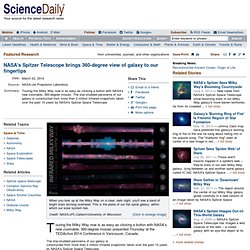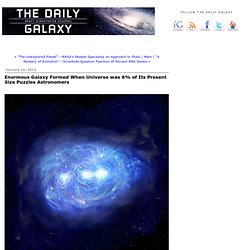

Que faut-il penser de G237, le proto-amas de galaxies découvert par Planck et qui déroute les cosmologistes ? L'étude des amas de galaxies nous renseigne sur bien des aspects de la cosmologie et de la cosmogonie, de la nature de la matière noire à l'effondrement gravitationnel à l'origine de bien des étoiles et des galaxies.

Universality of circular polarization in star- and planet-forming regions: Implications for the origin of homochirality. A research team with Jungmi KWON (GUAS/NAOJ) has performed deep imaging linear and circular polarimetry of the 'Cat's Paw Nebula' (NGC 6334) located in the constellation Scorpius, successfully detecting high degrees of circular polarization (CP) of as much as 22% in NGC 6334.

The detected CP degree is the highest ever observed. In addition, the team has presented the first systematic survey of a combination of linear and circular polarimetry in nine star- and planet-forming regions. As the results of statistical analysis of observations of various star-forming regions, CPs were detected in nine star- and planet-forming regions. Putting it differently, it can be said that CP is a universal feature of star- and planet-forming regions. The team's findings enable us to obtain information about magnetic fields of circumstellar structures around protostars, which is difficult to obtain using existing methods. Research Background What is the origin of life on Earth? More information: Kwon, J. □ Sursauts radio intergalactiques: 1652 en 47 jours provenant du même endroit. Déjà qu'un "sursaut radio intergalactique" est un des événements les plus puissants enregistrés dans le cosmos, que dire de plus de 1600 provenant du même endroit ?

Photo: Le radiotélescope FAST, dans les montagnes de la province du Guizhou / Jeff Dai, TWAN Ces "sursauts rapides" (en anglais, Fast Radio Bursts, ou FRB) représentent peut-être des millions de fois l'énergie (Dans le sens commun l'énergie désigne tout ce qui permet d'effectuer un travail, fabriquer de la...) du Soleil (Le Soleil (Sol en latin, Helios ou Ήλιος en grec) est l'étoile...). NASA's Spitzer Telescope brings 360-degree view of galaxy to our fingertips. Touring the Milky Way now is as easy as clicking a button with NASA's new zoomable, 360-degree mosaic presented Thursday at the TEDActive 2014 Conference in Vancouver, Canada.

The star-studded panorama of our galaxy is constructed from more than 2 million infrared snapshots taken over the past 10 years by NASA's Spitzer Space Telescope. "If we actually printed this out, we'd need a billboard as big as the Rose Bowl Stadium to display it," said Robert Hurt, an imaging specialist at NASA's Spitzer Space Science Center in Pasadena, Calif.
"Instead, we've created a digital viewer that anyone, even astronomers, can use. " The 20-gigapixel mosaic uses Microsoft's WorldWide Telescope visualization platform. It captures about three percent of our sky, but because it focuses on a band around Earth where the plane of the Milky Way lies, it shows more than half of all the galaxy's stars.
The Starburst Foundation. Hubble, Journey Through the Orion Nebula. Scientists Begin to Unravel Gigantic Space Ribbon. This 3-D diagram shows the ribbon (grey) wrapping around our bubble-like heliosphere like a belt.

Grey lines show the interstellar magnetic field lines astronomers believe creates this mysterious ribbon. Credit: Adler Planetarium/IBEX Team In 2009 astronomers using NASA’s Interstellar Boundary Explorer (IBEX) spacecraft accidentally came across a giant ribbon-like formation snaking its way across the boundary between our solar system and interstellar space. Ever since, its true nature has remained a riddle astronomers have been unable to solve. But now, they believe they are a step closer to explaining this bizarre structure. The solar system—the sun and all its planets—is surrounded by a protective magnetic bubble-like boundary called the heliosphere, which acts as a frontline against incoming cosmic rays and interstellar clouds.
The resulting particles stream back inward and form the ribbon of energized neutral atoms. La matière noire du centre galactique ? Enormous Galaxy Formed When Universe was 6% of Its Present Size Puzzles Astronomers. Himiko, a "space blob" named after a legendary queen from ancient Japan, is an enormous galaxy, with a hot glowing gaseous halo extending over 55,000 light-years.

Not only is Himiko very large, it is extraordinarily distant, seen at a time approximately 800 million years after the Big Bang, when the universe was only 6 percent of its present size and stars and galaxies were just beginning to form. The Hubble images, receiving optical and ultraviolet light, reveal three stellar clumps covering a space of 20,000 light-years. Each clump is the size of a typical luminous galaxy dating to the epoch of Himiko. Together, the clumps achieve a prodigious rate of star formation, equivalent to about one hundred solar masses per year. This is more than sufficient to explain the existence of Himiko and its gaseous halo. But a surprising anomaly emerged when Himiko was observed by ALMA. Ellis and his fellow astronomers did not come to this conclusion quickly. The Daily Galaxy via CalTech.
Trous noirs. Voie lactée.